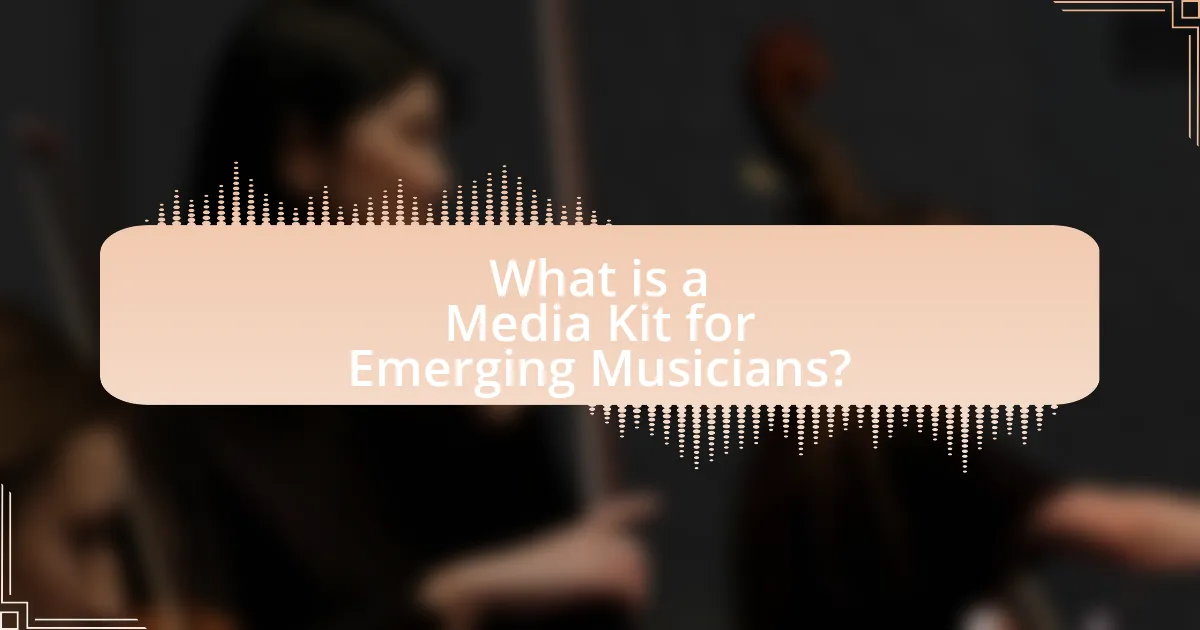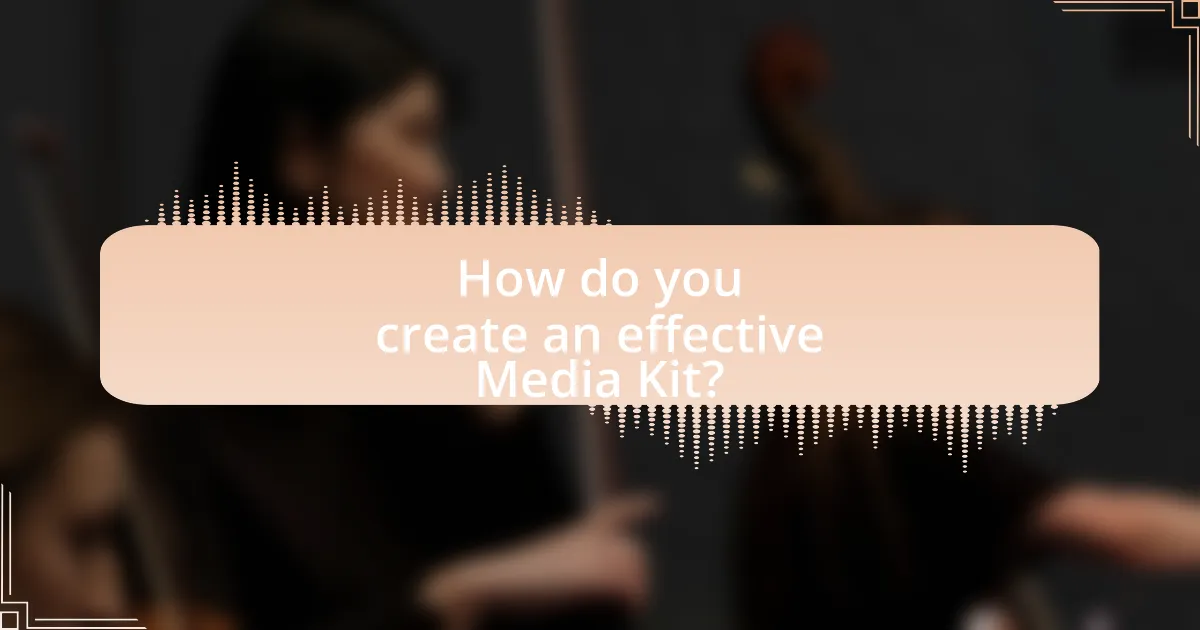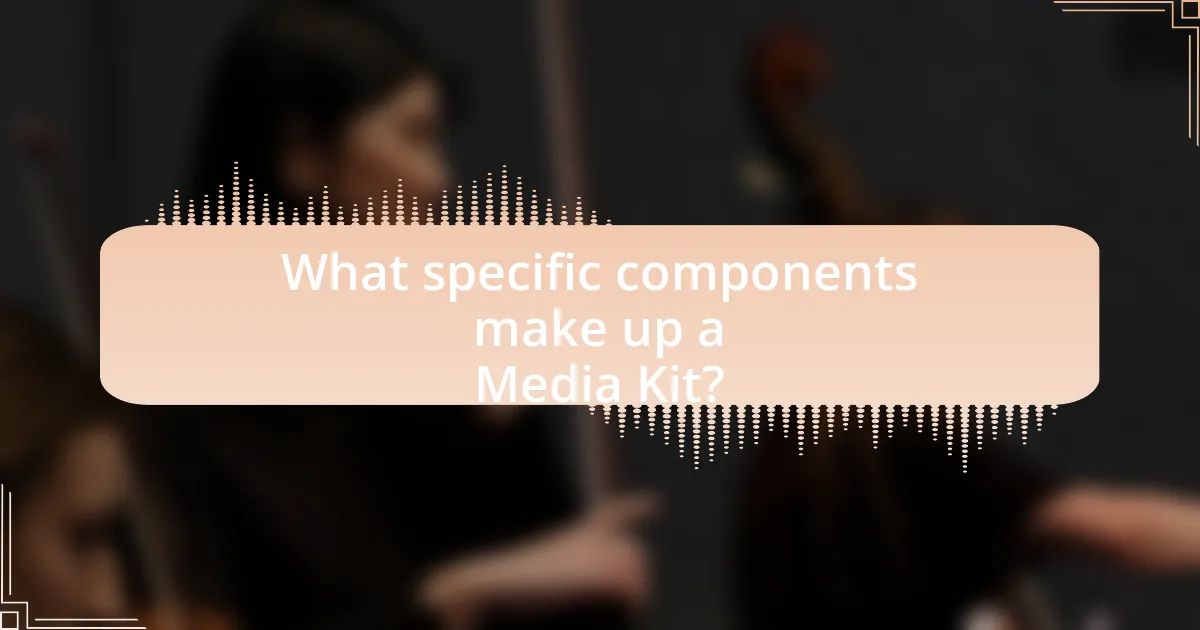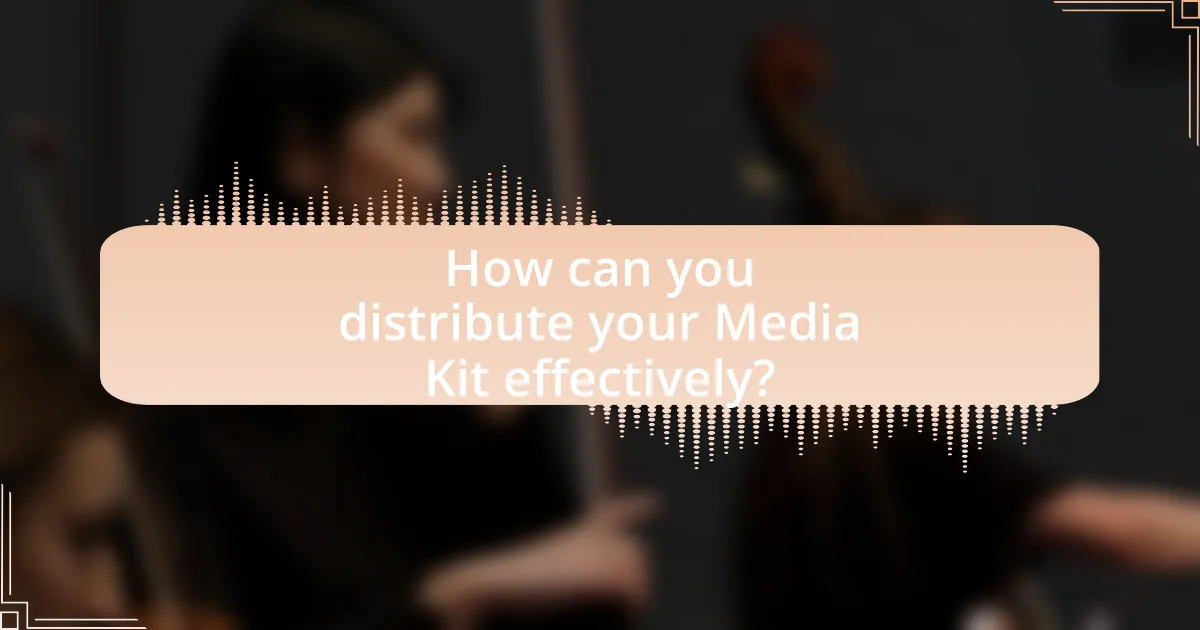A media kit for emerging musicians is a vital promotional tool that includes essential materials such as a biography, high-resolution images, music samples, press releases, and contact information. This comprehensive package helps artists effectively communicate their brand and achievements to industry professionals, increasing their visibility and opportunities for gigs and collaborations. The article outlines the importance of a media kit, key elements to include, best practices for design and distribution, and common mistakes to avoid, providing a thorough guide for musicians looking to enhance their professional image and reach within the music industry.

What is a Media Kit for Emerging Musicians?
A media kit for emerging musicians is a comprehensive package of promotional materials designed to showcase an artist’s work, achievements, and brand identity. This kit typically includes a biography, high-resolution photos, music samples, press coverage, and contact information, all aimed at facilitating media coverage, booking opportunities, and collaborations. The inclusion of these elements helps to present a professional image and provides essential information that journalists, promoters, and industry professionals need to understand the artist’s unique value and appeal.
Why is a Media Kit important for musicians?
A media kit is important for musicians because it serves as a comprehensive promotional tool that effectively communicates their brand, music, and achievements to industry professionals and potential collaborators. This kit typically includes essential elements such as a biography, high-resolution images, music samples, and press coverage, which collectively enhance a musician’s visibility and credibility. For instance, having a well-structured media kit can increase a musician’s chances of securing gigs, media coverage, and partnerships, as it provides all necessary information in a professional format that is easy to share.
What key elements should be included in a media kit?
A media kit for emerging musicians should include a biography, high-resolution images, music samples, press releases, and contact information. The biography provides background and context about the musician, while high-resolution images are essential for media use. Music samples showcase the artist’s work, and press releases inform about recent news or events. Contact information ensures that media representatives can reach the musician or their management easily. These elements collectively create a comprehensive resource for promoting the musician effectively.
How does a media kit enhance a musician’s visibility?
A media kit enhances a musician’s visibility by providing a comprehensive and professional presentation of their brand, music, and achievements. This toolkit typically includes high-quality images, a biography, press releases, and links to music, which facilitate easier access for media outlets, promoters, and potential collaborators. By streamlining the information that is shared, a media kit increases the likelihood of coverage in blogs, magazines, and social media platforms, thereby reaching a wider audience. Studies show that musicians with well-crafted media kits are more likely to secure interviews and features, as they present a polished image that appeals to industry professionals.
Who can benefit from a media kit?
Emerging musicians can benefit from a media kit. A media kit provides essential information about the artist, including their biography, music samples, press coverage, and contact details, which helps in promoting their work to venues, promoters, and media outlets. By having a well-structured media kit, emerging musicians can effectively communicate their brand and artistic vision, increasing their chances of securing gigs and media attention.
What types of musicians should create a media kit?
Emerging musicians, independent artists, and bands seeking to promote their music and secure opportunities should create a media kit. A media kit serves as a professional introduction, providing essential information such as biography, music samples, press photos, and contact details. This is particularly important for musicians aiming to attract booking agents, venues, and media coverage, as it presents a cohesive image and facilitates easier access to their work.
How can different genres influence the content of a media kit?
Different genres influence the content of a media kit by dictating the style, tone, and elements included to resonate with specific audiences. For instance, a rock music media kit may emphasize high-energy visuals and bold graphics, while a classical music kit might focus on elegance and sophistication in its design and language. Additionally, genre-specific terminology and references can be incorporated to connect with fans and industry professionals familiar with those styles. This tailored approach ensures that the media kit effectively communicates the artist’s identity and appeals to the target demographic, enhancing engagement and interest.

How do you create an effective Media Kit?
To create an effective Media Kit for emerging musicians, include essential elements such as a professional biography, high-quality images, music samples, press coverage, and contact information. A well-crafted biography should highlight the musician’s background, achievements, and unique style, while high-quality images should be suitable for publication and visually represent the artist’s brand. Music samples should showcase the best tracks, ideally in various formats, to cater to different media outlets. Including press coverage or testimonials adds credibility, and clear contact information ensures easy communication for booking or inquiries. These components collectively provide a comprehensive overview that can attract media attention and opportunities.
What are the steps to develop a media kit?
To develop a media kit, follow these steps: First, define your brand identity, including your mission, vision, and unique selling points. Next, gather essential materials such as a professional biography, high-quality images, and music samples. Then, create a press release that highlights your latest projects or achievements. After that, compile a list of media contacts and relevant publications for distribution. Finally, design the media kit in a visually appealing format, ensuring it is easy to navigate and includes all necessary information. These steps ensure that the media kit effectively communicates your brand to potential promoters, venues, and media outlets.
How do you gather the necessary information for your media kit?
To gather the necessary information for a media kit, emerging musicians should compile essential elements such as a biography, discography, press photos, and contact information. This process involves researching industry standards and reviewing successful media kits from established artists to understand what content resonates with audiences and media outlets. Additionally, musicians can collect testimonials, reviews, and statistics about their performances or streaming numbers to enhance credibility. By ensuring that all information is accurate and up-to-date, musicians can create a compelling media kit that effectively represents their brand and engages potential promoters and media.
What design elements should be considered in a media kit?
A media kit should consider design elements such as branding consistency, visual hierarchy, typography, color scheme, and imagery. Branding consistency ensures that all materials reflect the musician’s identity, creating a cohesive look that resonates with their audience. Visual hierarchy guides the viewer’s attention to the most important information first, using size and placement effectively. Typography should be legible and reflect the musician’s style, while the color scheme should align with their brand identity to evoke the desired emotional response. High-quality imagery, including professional photos and graphics, enhances the overall appeal and professionalism of the media kit. These elements collectively contribute to a polished presentation that effectively communicates the musician’s brand and message.
What common mistakes should be avoided when creating a media kit?
Common mistakes to avoid when creating a media kit include lacking clear branding, failing to include essential information, and using outdated or low-quality visuals. Clear branding is crucial as it helps establish a recognizable identity; without it, the media kit may fail to make a strong impression. Essential information, such as a biography, contact details, and social media links, must be included to provide a comprehensive overview of the musician. Additionally, outdated or low-quality visuals can detract from the professionalism of the kit, as high-quality images and current content are vital for engaging potential promoters and venues.
How can poor design impact the effectiveness of a media kit?
Poor design can significantly diminish the effectiveness of a media kit by failing to capture the attention of its intended audience. A media kit serves as a promotional tool for emerging musicians, and if it is visually unappealing or poorly organized, it can lead to a lack of engagement from industry professionals, such as promoters and record labels. Research indicates that 94% of first impressions are design-related, highlighting the critical role of aesthetics in communication. Additionally, a cluttered layout can obscure key information, making it difficult for recipients to quickly grasp the musician’s brand and offerings. This can result in missed opportunities for exposure and collaboration, ultimately hindering the musician’s career growth.
What information should never be included in a media kit?
A media kit should never include personal information such as home addresses, personal phone numbers, or private email addresses of the musicians. Including such sensitive information can lead to privacy violations and potential security risks. Additionally, irrelevant or outdated information, such as past projects that do not align with the current brand or image, should also be excluded to maintain focus and professionalism.

What specific components make up a Media Kit?
A Media Kit for emerging musicians typically includes several specific components: an artist biography, high-resolution images, music samples, press releases, and contact information. The artist biography provides a concise overview of the musician’s background, influences, and achievements, which helps media outlets understand their story. High-resolution images are essential for promotional purposes, allowing media to visually represent the artist in articles or features. Music samples, often in the form of links to streaming platforms or downloadable files, showcase the artist’s sound and style. Press releases inform the media about upcoming events, album releases, or significant milestones, while contact information ensures that journalists can easily reach the artist or their management for inquiries. These components collectively create a comprehensive and professional presentation that enhances the musician’s visibility and appeal to the media.
What is the role of an artist bio in a media kit?
An artist bio in a media kit serves to provide a concise overview of the artist’s background, achievements, and artistic vision. This essential component helps media professionals, promoters, and potential collaborators understand the artist’s identity and relevance in the music industry. A well-crafted bio can highlight key milestones, such as notable performances, awards, or unique influences, which establish credibility and attract interest. For instance, including specific achievements like chart rankings or collaborations with recognized artists can enhance the artist’s profile and facilitate connections within the industry.
How can you write an engaging artist bio?
To write an engaging artist bio, focus on conveying your unique story, artistic journey, and achievements in a compelling manner. Start with a strong opening that captures attention, such as a defining moment in your career or a personal anecdote that reflects your artistic identity. Include key details like your musical influences, notable performances, and any awards or recognitions you have received. Use a conversational tone to connect with your audience, and keep the bio concise, ideally between 150 to 300 words, to maintain interest. Highlight your current projects and future aspirations to give readers a sense of your direction. Engaging bios often include quotes or testimonials from industry professionals to add credibility and depth.
What details should be highlighted in an artist bio?
An artist bio should highlight key details such as the artist’s background, musical style, notable achievements, and influences. The background provides context about the artist’s origins and journey, while the musical style defines their genre and unique sound. Notable achievements, such as awards, chart positions, or significant performances, establish credibility and recognition in the industry. Influences offer insight into the artist’s creative inspirations, helping audiences connect with their work. These elements collectively create a comprehensive picture of the artist, essential for engaging potential fans and industry professionals.
How important are visuals in a media kit?
Visuals are crucial in a media kit as they enhance engagement and convey information effectively. Research indicates that visual content is processed 60,000 times faster than text, making it essential for capturing attention quickly. Additionally, studies show that including visuals can increase retention rates by up to 65%, which is vital for emerging musicians aiming to make a memorable impression. Therefore, the strategic use of images, graphics, and videos in a media kit significantly boosts its effectiveness in promoting an artist’s brand and music.
What types of images should be included in a media kit?
A media kit for emerging musicians should include high-resolution images such as professional headshots, performance shots, and behind-the-scenes photos. Professional headshots establish a recognizable image for branding, while performance shots showcase the musician’s stage presence and energy, essential for promotional purposes. Behind-the-scenes photos provide a personal touch, allowing fans and media to connect with the artist’s journey. Including a variety of these images enhances the media kit’s appeal and effectiveness in attracting attention from promoters, venues, and media outlets.
How can professional photography enhance a media kit?
Professional photography can significantly enhance a media kit by providing high-quality, visually appealing images that capture the essence of the musician and their brand. These images create a strong first impression, making the media kit more engaging and memorable for industry professionals, promoters, and media outlets. Research indicates that visual content can increase engagement rates by up to 94%, highlighting the importance of professional imagery in effectively communicating a musician’s identity and artistic vision.
What promotional materials should be included in a media kit?
A media kit for emerging musicians should include a press release, artist biography, high-resolution images, music samples, and contact information. The press release provides essential news about the artist, while the biography offers background and context. High-resolution images are crucial for media use, and music samples allow potential promoters and venues to evaluate the artist’s sound. Contact information ensures that interested parties can reach out for bookings or interviews. These materials collectively enhance the artist’s visibility and professionalism in the industry.
How do press releases fit into a media kit?
Press releases are essential components of a media kit, serving as formal announcements that provide journalists and media outlets with key information about an emerging musician’s activities, such as album releases, tours, or significant events. They fit into a media kit by offering a concise narrative that highlights the musician’s brand, achievements, and newsworthy updates, which can attract media coverage and public interest. The inclusion of press releases in a media kit ensures that all relevant information is readily available, facilitating easier access for media professionals and enhancing the musician’s visibility in the industry.
What are the benefits of including music samples in a media kit?
Including music samples in a media kit enhances an artist’s ability to showcase their sound and style effectively. Music samples provide potential collaborators, promoters, and media outlets with immediate access to the artist’s work, facilitating quicker decision-making regarding partnerships and features. Research indicates that 70% of music industry professionals prefer receiving music samples in media kits, as it allows them to assess the artist’s fit for their projects more efficiently. By including high-quality samples, musicians can create a strong first impression, increase their chances of securing gigs, and attract a wider audience.

How can you distribute your Media Kit effectively?
To distribute your Media Kit effectively, utilize multiple channels such as email, social media, and your website. Email allows for direct communication with industry contacts, while social media platforms can reach a broader audience and engage fans. Additionally, hosting the Media Kit on your website ensures easy access for journalists and promoters. According to a study by HubSpot, 78% of marketers have seen an increase in engagement through social media, highlighting its effectiveness in distribution.
What are the best platforms for sharing a media kit?
The best platforms for sharing a media kit include Dropbox, Google Drive, and Issuu. Dropbox and Google Drive allow for easy file sharing and collaboration, making them ideal for distributing high-resolution images, press releases, and other media kit components. Issuu offers a visually appealing way to present media kits as digital publications, enhancing engagement with potential partners and media outlets. These platforms are widely used in the industry, ensuring accessibility and ease of use for emerging musicians looking to promote their work effectively.
How can social media be utilized to promote a media kit?
Social media can be utilized to promote a media kit by sharing engaging content that highlights the key elements of the kit, such as artist bios, press releases, and high-quality images. Platforms like Instagram and Twitter allow musicians to reach a broad audience quickly; for instance, posting visually appealing graphics or snippets from the media kit can attract attention and encourage shares. Additionally, using targeted hashtags and collaborating with influencers can enhance visibility, as studies show that posts with relevant hashtags can increase engagement by up to 12.6%. By consistently promoting the media kit across various social media channels, musicians can effectively increase their reach and attract media coverage.
What role do email campaigns play in media kit distribution?
Email campaigns serve a crucial role in media kit distribution by facilitating direct communication between musicians and industry stakeholders. These campaigns enable musicians to effectively share their media kits with targeted audiences, such as promoters, venues, and press contacts, ensuring that the right people receive the information needed to consider booking or featuring the artist. According to a study by Campaign Monitor, email marketing has an average ROI of 4400%, highlighting its effectiveness in reaching and engaging audiences. This demonstrates that well-crafted email campaigns can significantly enhance the visibility and impact of a media kit, ultimately aiding in the musician’s promotional efforts.
How can you measure the success of your media kit?
You can measure the success of your media kit by analyzing metrics such as media coverage, engagement rates, and feedback from industry professionals. Media coverage can be quantified by tracking the number of press mentions and articles published that reference your media kit. Engagement rates can be assessed through social media interactions, website traffic, and email open rates linked to the distribution of the media kit. Additionally, soliciting direct feedback from journalists and influencers who received the kit can provide qualitative insights into its effectiveness. These metrics collectively indicate how well the media kit resonates with its intended audience and its impact on promoting the musician.
What metrics should be tracked after distributing a media kit?
After distributing a media kit, the key metrics to track include media coverage, engagement rates, website traffic, social media mentions, and conversion rates. Media coverage can be assessed by monitoring the number of articles, blog posts, or features that mention the musician or their work, indicating the reach of the media kit. Engagement rates, such as likes, shares, and comments on social media posts related to the media kit, provide insight into audience interaction. Website traffic should be analyzed through analytics tools to determine any spikes in visits following the distribution, reflecting interest generated by the media kit. Social media mentions can be tracked using monitoring tools to gauge public sentiment and awareness. Lastly, conversion rates, such as ticket sales or streaming numbers, can be evaluated to measure the direct impact of the media kit on the musician’s success.
How can feedback improve future media kits?
Feedback can significantly enhance future media kits by identifying strengths and weaknesses in content and presentation. By collecting input from industry professionals, musicians, and target audiences, creators can refine messaging, improve visual design, and ensure that essential information is effectively communicated. For instance, a survey conducted by the Music Industry Research Association found that 75% of music professionals believe that tailored media kits lead to better engagement with potential collaborators. This data underscores the importance of incorporating feedback to create more impactful and relevant media kits for emerging musicians.
What are some best practices for creating a media kit?
Best practices for creating a media kit include ensuring it is visually appealing, concise, and informative. A well-designed media kit should feature high-quality images, a compelling biography, and key statistics about the musician’s achievements, such as streaming numbers or social media following. Additionally, including contact information and links to music samples or videos enhances accessibility. Research indicates that 70% of journalists prefer media kits that are easy to navigate and contain essential information upfront, which underscores the importance of clarity and organization in the presentation.
How often should a media kit be updated?
A media kit should be updated at least once a year or whenever significant changes occur, such as new releases, changes in branding, or shifts in target audience. Regular updates ensure that the information remains relevant and accurately reflects the musician’s current status and offerings. For instance, if an emerging musician releases a new album or undergoes a major career shift, updating the media kit promptly is essential to maintain effective communication with media and industry professionals.
What tips can help ensure your media kit stands out?
To ensure your media kit stands out, focus on high-quality visuals and concise, engaging content. High-resolution images and professional design elements capture attention and convey professionalism, which is crucial for emerging musicians aiming to make a strong impression. Additionally, including a compelling artist bio, notable achievements, and unique selling points helps differentiate you from others in the industry. According to a study by the International Music Summit, 70% of industry professionals prioritize visual appeal when reviewing media kits, underscoring the importance of aesthetics in making a memorable impact.